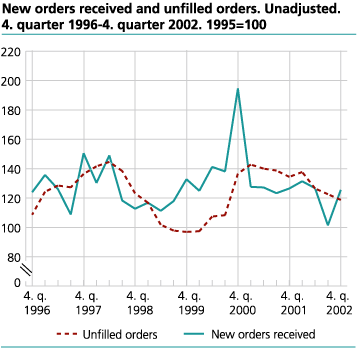Content
Published:
This is an archived release.
Low stocks in manufacturing
Total stocks continued to decline throughout the 4th quarter of 2002 and are noticeably lower than in the corresponding quarter last year. On the other hand new orders show a growth and are almost back to the level from the first half of 2002.
Total stocks have declined in six of the last seven quarters. New orders were considerably up in the 4th quarter of 2002, but are somewhat unchanged compared with figures from the corresponding quarter last year. A growing demand in both domestic and export market can explain this.
| Change in value for new orders received and unfilled orders. Per cent |
| Industrial Classification | New orders received (trend)1 | Unfilled orders (original series) | |||||||||||||||||||||||||||||||||||||
|---|---|---|---|---|---|---|---|---|---|---|---|---|---|---|---|---|---|---|---|---|---|---|---|---|---|---|---|---|---|---|---|---|---|---|---|---|---|---|---|
| 2.q.02 - 3.q.02 | 3.q.02 - 4.q.02 | 4.q.01 - 4.q.02 | |||||||||||||||||||||||||||||||||||||
| Total | -2.0 | -1.8 | -11.7 | ||||||||||||||||||||||||||||||||||||
| Basic Chemicals | -19.9 | -13.5 | -36.1 | ||||||||||||||||||||||||||||||||||||
| Basic Metals | -13.4 | -13.6 | -2.5 | ||||||||||||||||||||||||||||||||||||
| Machinery and Equipment | -9.8 | 0.6 | -13.2 | ||||||||||||||||||||||||||||||||||||
| Oil Platforms and Modules | 12.2 | -3.6 | 30.8 | ||||||||||||||||||||||||||||||||||||
| 1 | Estimated annual changes in trend series, based on change in percentage from previous quarter. |
Contact
-
Statistics Norway's Information Centre
E-mail: informasjon@ssb.no
tel.: (+47) 21 09 46 42

